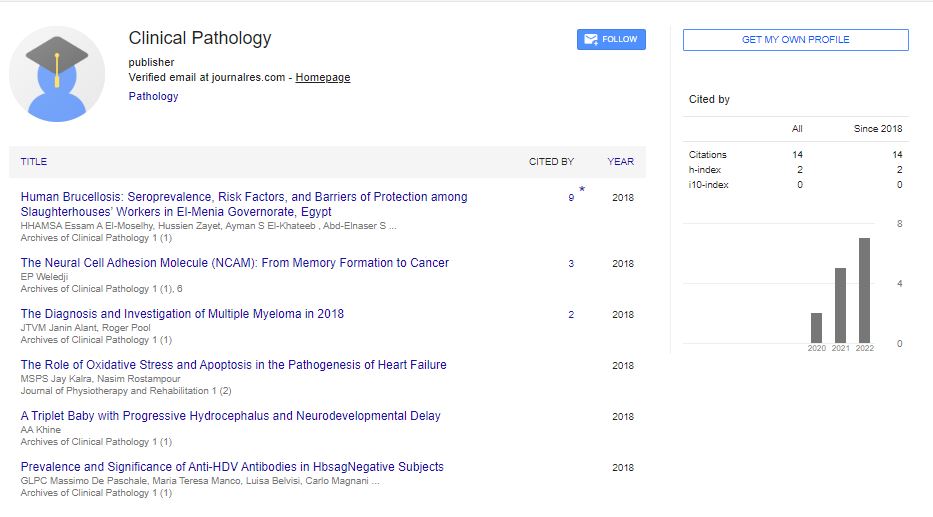Commentary, Arch Clin Pathol Vol: 6 Issue: 3
Understanding the Pathology of Testicular Cancer
Akinobu Zhou*
1Department of Urology, International University of Health and Welfare Narita Hospital, Chiba, Japan
*Corresponding Author: Akinobu Zhou,
Department of Urology, International
University of Health and Welfare Narita Hospital, Chiba, Japan
E-mail: zhouaki3@iuhw.ac.jp
Received date: 30 August, 2023, Manuscript No. ACPY-23-117817;
Editor assigned date: 01 September, 2023, PreQC No. ACPY-23-117817 (PQ);
Reviewed date: 15 September, 2023, QC No. ACPY-23-117817;
Revised date: 22 September, 2023, Manuscript No. ACPY-23-117817 (R);
Published date: 02 October, 2023, DOI:2324-8955/acpy.05.03.100096
Citation: Zhou A (2023) Understanding the Pathology of Testicular Cancer. Arch Clin Pathol 6:3.
Abstract
Testicular cancer is a relatively rare but highly treatable form of cancer that primarily affects young men. This disease begins in the testicles, the male reproductive organs responsible for producing sperm and testosterone. Understanding the pathology of testicular cancer is critical for early diagnosis, effective treatment, and improved patient outcomes. Before delving into the pathology of testicular cancer, it's important to understand the basic anatomy of the testicles. These small, egg-shaped organs are situated within the scrotum, below the penis. They are made up of different types of cells, including germ cells (responsible for sperm production) and supporting cells. The vast majority of testicular cancers develop from germ cells and are categorized into two main types: seminoma and non-seminoma.
Description
Testicular cancer is a relatively rare but highly treatable form of cancer that primarily affects young men. This disease begins in the testicles, the male reproductive organs responsible for producing sperm and testosterone. Understanding the pathology of testicular cancer is critical for early diagnosis, effective treatment, and improved patient outcomes. Before delving into the pathology of testicular cancer, it's important to understand the basic anatomy of the testicles. These small, egg-shaped organs are situated within the scrotum, below the penis. They are made up of different types of cells, including germ cells (responsible for sperm production) and supporting cells. The vast majority of testicular cancers develop from germ cells and are categorized into two main types: seminoma and non-seminoma.
Germ cell tumors
Seminoma: Seminomas are a type of testicular cancer that originates from germ cells. They are typically slow-growing and have a good prognosis. The pathology of seminoma involves the formation of malignant cells that closely resemble primitive germ cells. These cells typically contain a clear cytoplasm and are more sensitive to radiation therapy.
Non-seminoma: Non-Seminomatous Germ Cell Tumors (NSGCTs) are a more aggressive form of testicular cancer. This category includes various subtypes such as embryonal carcinoma, yolk sac carcinoma, choriocarcinoma, and teratoma. The pathology of NSGCTs is characterized by a heterogeneous mixture of cell types within the tumor, often containing elements from more than one subtype. Because of their mixed nature, non-seminomas are usually more challenging to treat.
Testicular cancer typically arises when errors occur during the development of germ cells. These errors can lead to uncontrolled cell growth and the formation of tumors. Although the exact causes of these errors are not always clear, certain risk factors, including a family history of testicular cancer, cryptorchidism (undescended testicles), and genetic conditions like Klinefelter syndrome, may increase a person's susceptibility to this disease.
Pathological stages, diagnosis and treatment
The pathology of testicular cancer is also categorized by stages, which indicate the extent of the disease's spread:.
• Stage I: The cancer is confined to the testicle.
• Stage II: The cancer has spread to lymph nodes in the abdomen.
• Stage III: The cancer has metastasized to distant organs, such as the lungs or liver.
Diagnosis of testicular cancer often begins with a physical examination, followed by ultrasound imaging and blood tests to measure tumor markers. The most common tumor markers for testicular cancer are Alpha-Fetoprotein (AFP), Human Chorionic Gonadotropin (HCG), and Lactate Dehydrogenase (LDH). The primary treatment for testicular cancer is surgical removal of the affected testicle, a procedure called a radical inguinal orchiectomy. Following surgery, treatment may involve additional therapies, such as chemotherapy, radiation therapy, or surveillance, depending on the type and stage of the cancer.
Conclusion
Testicular cancer, while relatively rare, is a highly curable disease when detected and treated early. Understanding the pathology of this cancer is essential for both medical professionals and the general public. Regular self-exams, awareness of risk factors, and early medical attention can play a significant role in improving the prognosis and quality of life for those affected by this form of cancer. Timely intervention, coupled with advances in treatment options, offers hope for individuals diagnosed with testicular cancer, ensuring that the threat it poses remains silent no more.
 Spanish
Spanish  Chinese
Chinese  Russian
Russian  German
German  French
French  Japanese
Japanese  Portuguese
Portuguese  Hindi
Hindi 